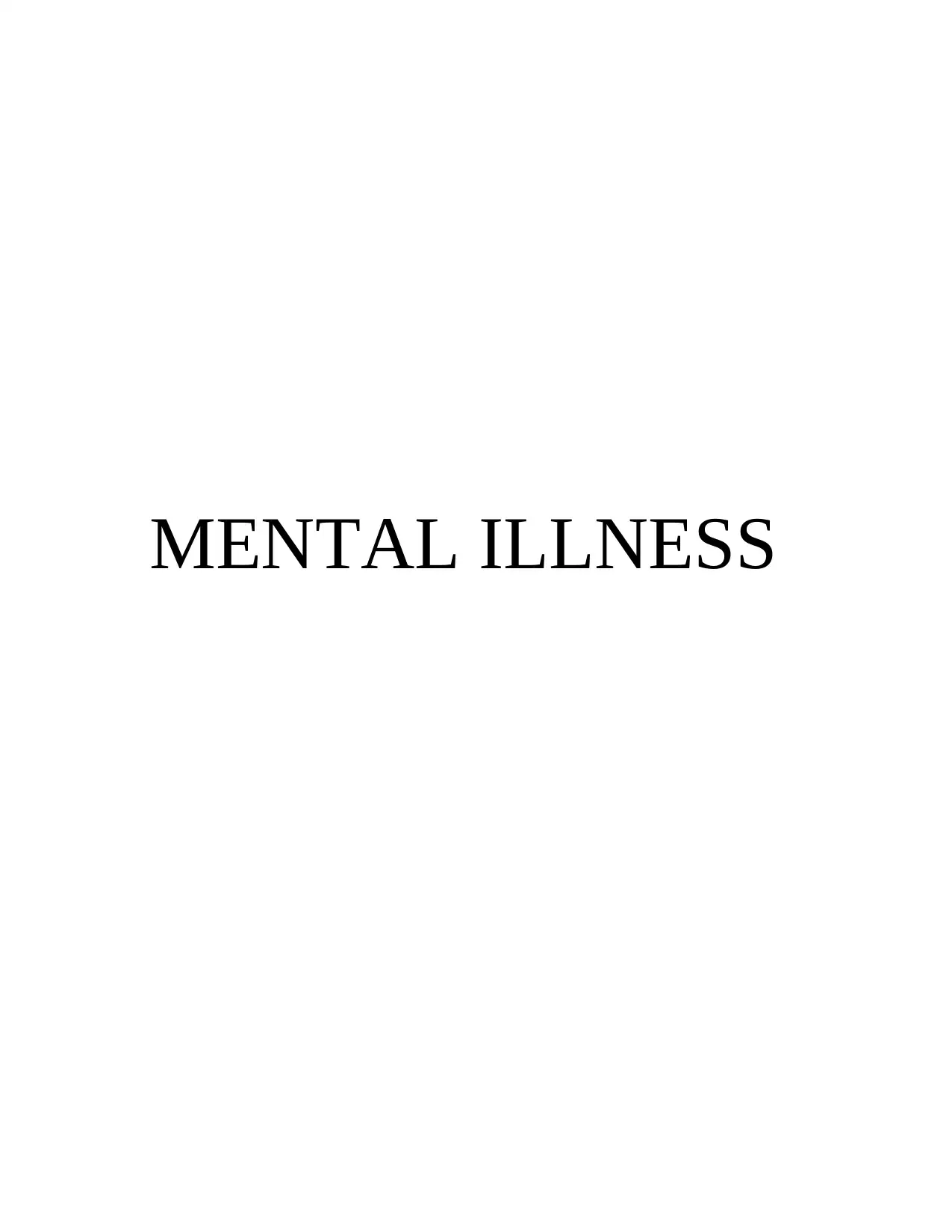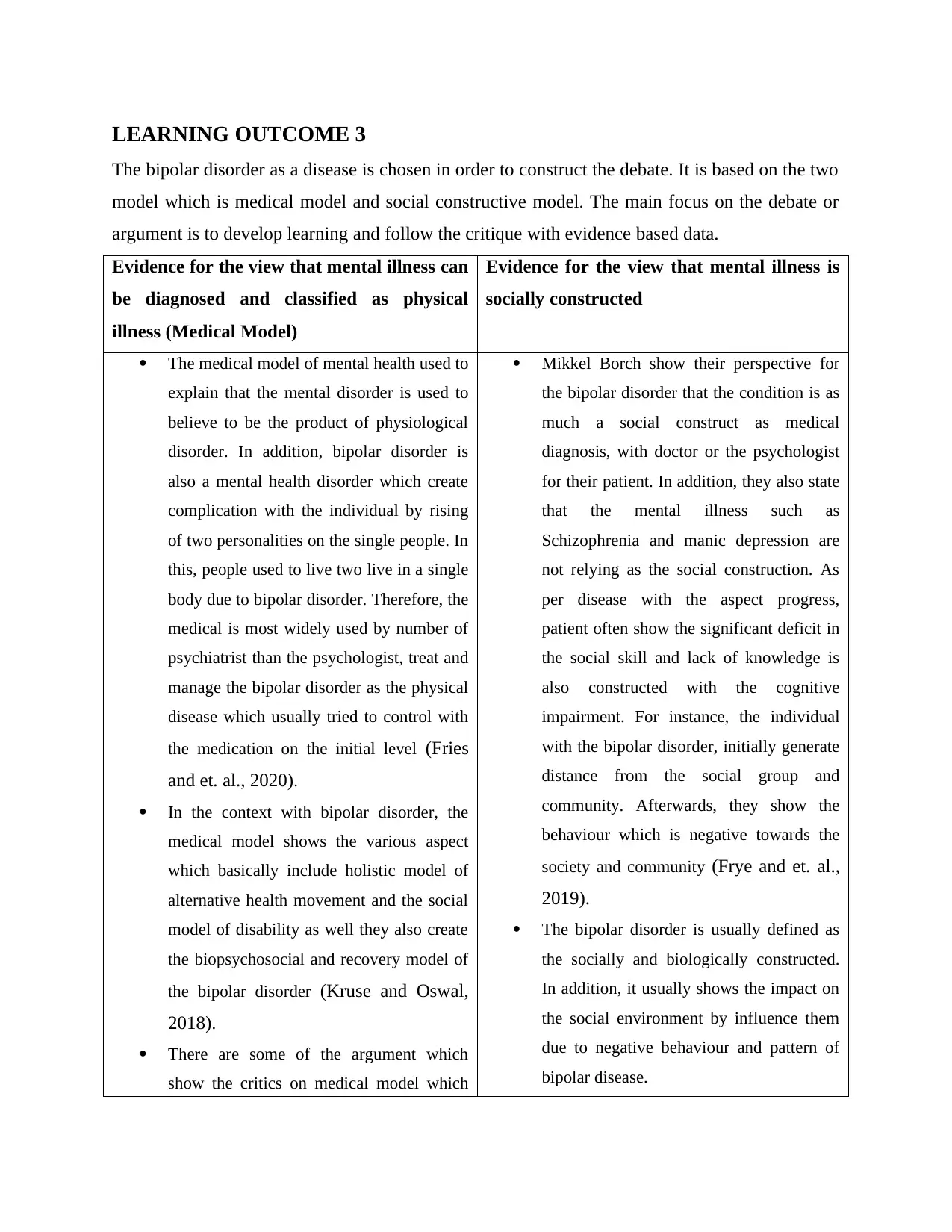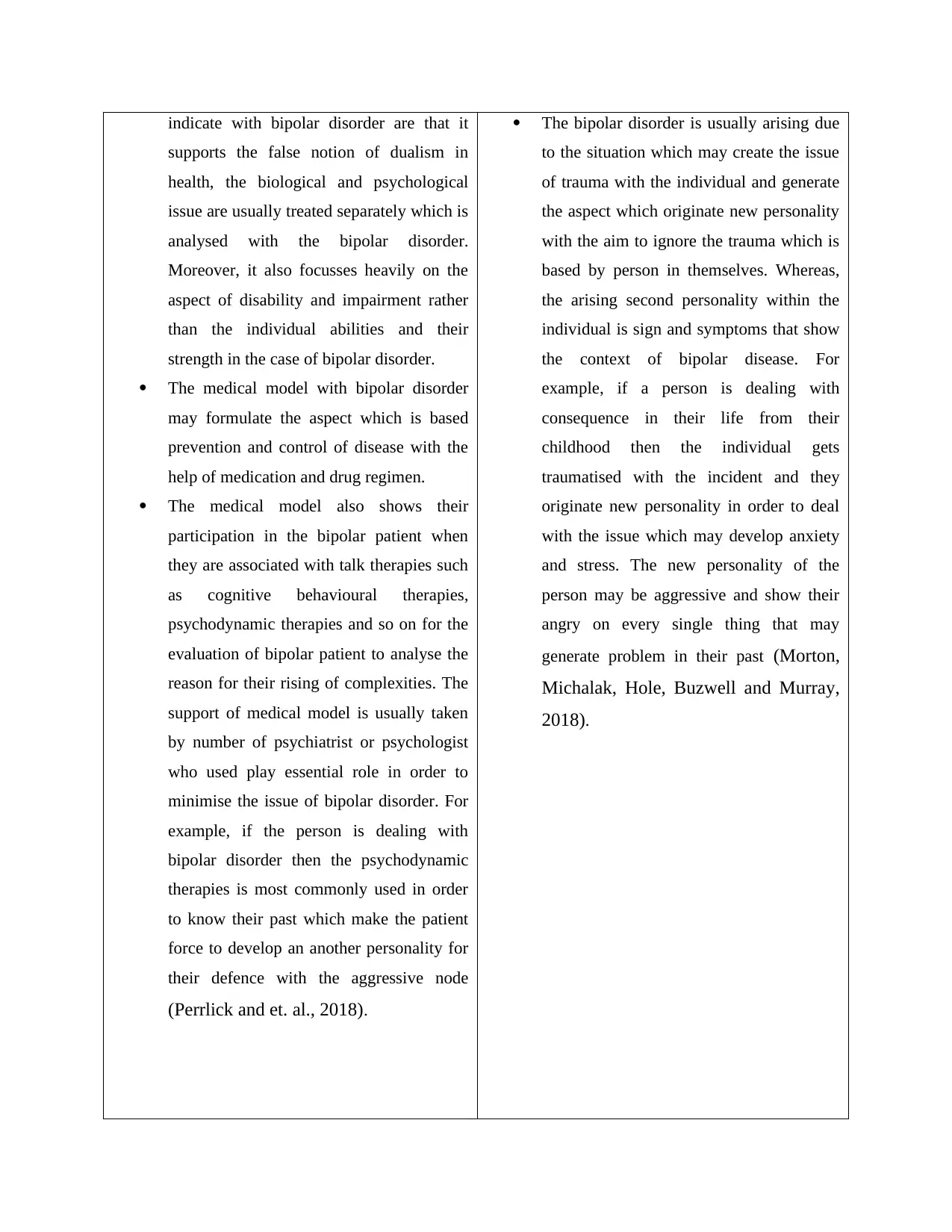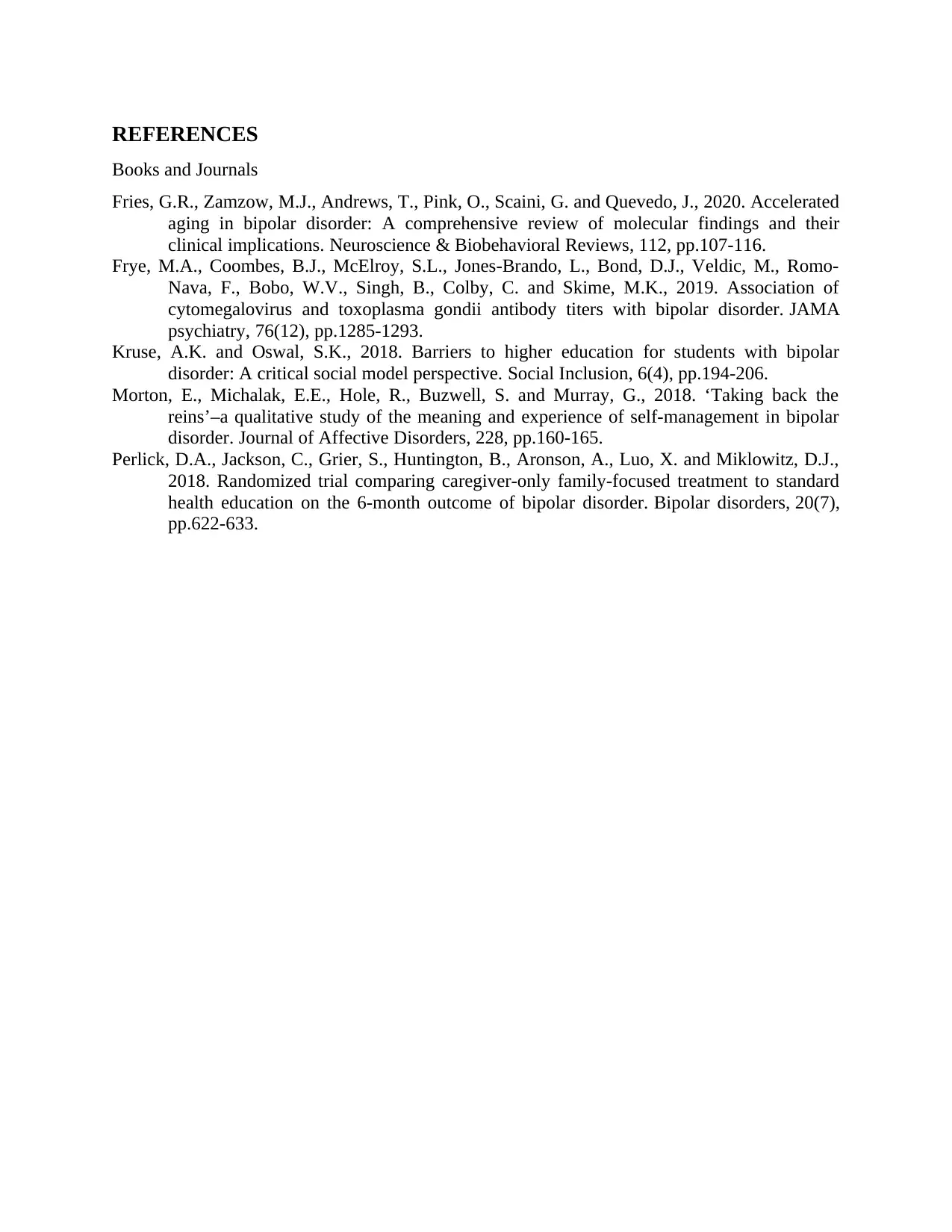Examining Bipolar Disorder Through Medical and Social Construct Models
VerifiedAdded on 2023/06/12
|6
|1084
|466
Essay
AI Summary
This essay delves into the debate surrounding the diagnosis and classification of mental illness, specifically focusing on bipolar disorder. It contrasts the medical model, which views mental illness as a physical disease with physiological origins, against the social construct model, which argues that mental illness is shaped by social and environmental factors. The essay uses evidence-based data to critique both perspectives, highlighting how the medical model emphasizes biological and psychological aspects, often treating them separately and potentially overlooking trauma, while the social construct model considers the impact of social environments and individual abilities. Ultimately, the essay explores how these models influence treatment approaches, such as medication and therapies, and their implications for individuals living with bipolar disorder. Desklib provides a platform for students to access similar essays and study tools to further their understanding.

MENTAL ILLNESS
Paraphrase This Document
Need a fresh take? Get an instant paraphrase of this document with our AI Paraphraser

Table of Contents
LEARNING OUTCOME 3.............................................................................................................3
REFERENCES................................................................................................................................6
LEARNING OUTCOME 3.............................................................................................................3
REFERENCES................................................................................................................................6

LEARNING OUTCOME 3
The bipolar disorder as a disease is chosen in order to construct the debate. It is based on the two
model which is medical model and social constructive model. The main focus on the debate or
argument is to develop learning and follow the critique with evidence based data.
Evidence for the view that mental illness can
be diagnosed and classified as physical
illness (Medical Model)
Evidence for the view that mental illness is
socially constructed
The medical model of mental health used to
explain that the mental disorder is used to
believe to be the product of physiological
disorder. In addition, bipolar disorder is
also a mental health disorder which create
complication with the individual by rising
of two personalities on the single people. In
this, people used to live two live in a single
body due to bipolar disorder. Therefore, the
medical is most widely used by number of
psychiatrist than the psychologist, treat and
manage the bipolar disorder as the physical
disease which usually tried to control with
the medication on the initial level (Fries
and et. al., 2020).
In the context with bipolar disorder, the
medical model shows the various aspect
which basically include holistic model of
alternative health movement and the social
model of disability as well they also create
the biopsychosocial and recovery model of
the bipolar disorder (Kruse and Oswal,
2018).
There are some of the argument which
show the critics on medical model which
Mikkel Borch show their perspective for
the bipolar disorder that the condition is as
much a social construct as medical
diagnosis, with doctor or the psychologist
for their patient. In addition, they also state
that the mental illness such as
Schizophrenia and manic depression are
not relying as the social construction. As
per disease with the aspect progress,
patient often show the significant deficit in
the social skill and lack of knowledge is
also constructed with the cognitive
impairment. For instance, the individual
with the bipolar disorder, initially generate
distance from the social group and
community. Afterwards, they show the
behaviour which is negative towards the
society and community (Frye and et. al.,
2019).
The bipolar disorder is usually defined as
the socially and biologically constructed.
In addition, it usually shows the impact on
the social environment by influence them
due to negative behaviour and pattern of
bipolar disease.
The bipolar disorder as a disease is chosen in order to construct the debate. It is based on the two
model which is medical model and social constructive model. The main focus on the debate or
argument is to develop learning and follow the critique with evidence based data.
Evidence for the view that mental illness can
be diagnosed and classified as physical
illness (Medical Model)
Evidence for the view that mental illness is
socially constructed
The medical model of mental health used to
explain that the mental disorder is used to
believe to be the product of physiological
disorder. In addition, bipolar disorder is
also a mental health disorder which create
complication with the individual by rising
of two personalities on the single people. In
this, people used to live two live in a single
body due to bipolar disorder. Therefore, the
medical is most widely used by number of
psychiatrist than the psychologist, treat and
manage the bipolar disorder as the physical
disease which usually tried to control with
the medication on the initial level (Fries
and et. al., 2020).
In the context with bipolar disorder, the
medical model shows the various aspect
which basically include holistic model of
alternative health movement and the social
model of disability as well they also create
the biopsychosocial and recovery model of
the bipolar disorder (Kruse and Oswal,
2018).
There are some of the argument which
show the critics on medical model which
Mikkel Borch show their perspective for
the bipolar disorder that the condition is as
much a social construct as medical
diagnosis, with doctor or the psychologist
for their patient. In addition, they also state
that the mental illness such as
Schizophrenia and manic depression are
not relying as the social construction. As
per disease with the aspect progress,
patient often show the significant deficit in
the social skill and lack of knowledge is
also constructed with the cognitive
impairment. For instance, the individual
with the bipolar disorder, initially generate
distance from the social group and
community. Afterwards, they show the
behaviour which is negative towards the
society and community (Frye and et. al.,
2019).
The bipolar disorder is usually defined as
the socially and biologically constructed.
In addition, it usually shows the impact on
the social environment by influence them
due to negative behaviour and pattern of
bipolar disease.
⊘ This is a preview!⊘
Do you want full access?
Subscribe today to unlock all pages.

Trusted by 1+ million students worldwide

indicate with bipolar disorder are that it
supports the false notion of dualism in
health, the biological and psychological
issue are usually treated separately which is
analysed with the bipolar disorder.
Moreover, it also focusses heavily on the
aspect of disability and impairment rather
than the individual abilities and their
strength in the case of bipolar disorder.
The medical model with bipolar disorder
may formulate the aspect which is based
prevention and control of disease with the
help of medication and drug regimen.
The medical model also shows their
participation in the bipolar patient when
they are associated with talk therapies such
as cognitive behavioural therapies,
psychodynamic therapies and so on for the
evaluation of bipolar patient to analyse the
reason for their rising of complexities. The
support of medical model is usually taken
by number of psychiatrist or psychologist
who used play essential role in order to
minimise the issue of bipolar disorder. For
example, if the person is dealing with
bipolar disorder then the psychodynamic
therapies is most commonly used in order
to know their past which make the patient
force to develop an another personality for
their defence with the aggressive node
(Perrlick and et. al., 2018).
The bipolar disorder is usually arising due
to the situation which may create the issue
of trauma with the individual and generate
the aspect which originate new personality
with the aim to ignore the trauma which is
based by person in themselves. Whereas,
the arising second personality within the
individual is sign and symptoms that show
the context of bipolar disease. For
example, if a person is dealing with
consequence in their life from their
childhood then the individual gets
traumatised with the incident and they
originate new personality in order to deal
with the issue which may develop anxiety
and stress. The new personality of the
person may be aggressive and show their
angry on every single thing that may
generate problem in their past (Morton,
Michalak, Hole, Buzwell and Murray,
2018).
supports the false notion of dualism in
health, the biological and psychological
issue are usually treated separately which is
analysed with the bipolar disorder.
Moreover, it also focusses heavily on the
aspect of disability and impairment rather
than the individual abilities and their
strength in the case of bipolar disorder.
The medical model with bipolar disorder
may formulate the aspect which is based
prevention and control of disease with the
help of medication and drug regimen.
The medical model also shows their
participation in the bipolar patient when
they are associated with talk therapies such
as cognitive behavioural therapies,
psychodynamic therapies and so on for the
evaluation of bipolar patient to analyse the
reason for their rising of complexities. The
support of medical model is usually taken
by number of psychiatrist or psychologist
who used play essential role in order to
minimise the issue of bipolar disorder. For
example, if the person is dealing with
bipolar disorder then the psychodynamic
therapies is most commonly used in order
to know their past which make the patient
force to develop an another personality for
their defence with the aggressive node
(Perrlick and et. al., 2018).
The bipolar disorder is usually arising due
to the situation which may create the issue
of trauma with the individual and generate
the aspect which originate new personality
with the aim to ignore the trauma which is
based by person in themselves. Whereas,
the arising second personality within the
individual is sign and symptoms that show
the context of bipolar disease. For
example, if a person is dealing with
consequence in their life from their
childhood then the individual gets
traumatised with the incident and they
originate new personality in order to deal
with the issue which may develop anxiety
and stress. The new personality of the
person may be aggressive and show their
angry on every single thing that may
generate problem in their past (Morton,
Michalak, Hole, Buzwell and Murray,
2018).
Paraphrase This Document
Need a fresh take? Get an instant paraphrase of this document with our AI Paraphraser


REFERENCES
Books and Journals
Fries, G.R., Zamzow, M.J., Andrews, T., Pink, O., Scaini, G. and Quevedo, J., 2020. Accelerated
aging in bipolar disorder: A comprehensive review of molecular findings and their
clinical implications. Neuroscience & Biobehavioral Reviews, 112, pp.107-116.
Frye, M.A., Coombes, B.J., McElroy, S.L., Jones-Brando, L., Bond, D.J., Veldic, M., Romo-
Nava, F., Bobo, W.V., Singh, B., Colby, C. and Skime, M.K., 2019. Association of
cytomegalovirus and toxoplasma gondii antibody titers with bipolar disorder. JAMA
psychiatry, 76(12), pp.1285-1293.
Kruse, A.K. and Oswal, S.K., 2018. Barriers to higher education for students with bipolar
disorder: A critical social model perspective. Social Inclusion, 6(4), pp.194-206.
Morton, E., Michalak, E.E., Hole, R., Buzwell, S. and Murray, G., 2018. ‘Taking back the
reins’–a qualitative study of the meaning and experience of self-management in bipolar
disorder. Journal of Affective Disorders, 228, pp.160-165.
Perlick, D.A., Jackson, C., Grier, S., Huntington, B., Aronson, A., Luo, X. and Miklowitz, D.J.,
2018. Randomized trial comparing caregiver‐only family‐focused treatment to standard
health education on the 6‐month outcome of bipolar disorder. Bipolar disorders, 20(7),
pp.622-633.
Books and Journals
Fries, G.R., Zamzow, M.J., Andrews, T., Pink, O., Scaini, G. and Quevedo, J., 2020. Accelerated
aging in bipolar disorder: A comprehensive review of molecular findings and their
clinical implications. Neuroscience & Biobehavioral Reviews, 112, pp.107-116.
Frye, M.A., Coombes, B.J., McElroy, S.L., Jones-Brando, L., Bond, D.J., Veldic, M., Romo-
Nava, F., Bobo, W.V., Singh, B., Colby, C. and Skime, M.K., 2019. Association of
cytomegalovirus and toxoplasma gondii antibody titers with bipolar disorder. JAMA
psychiatry, 76(12), pp.1285-1293.
Kruse, A.K. and Oswal, S.K., 2018. Barriers to higher education for students with bipolar
disorder: A critical social model perspective. Social Inclusion, 6(4), pp.194-206.
Morton, E., Michalak, E.E., Hole, R., Buzwell, S. and Murray, G., 2018. ‘Taking back the
reins’–a qualitative study of the meaning and experience of self-management in bipolar
disorder. Journal of Affective Disorders, 228, pp.160-165.
Perlick, D.A., Jackson, C., Grier, S., Huntington, B., Aronson, A., Luo, X. and Miklowitz, D.J.,
2018. Randomized trial comparing caregiver‐only family‐focused treatment to standard
health education on the 6‐month outcome of bipolar disorder. Bipolar disorders, 20(7),
pp.622-633.
⊘ This is a preview!⊘
Do you want full access?
Subscribe today to unlock all pages.

Trusted by 1+ million students worldwide
1 out of 6
Related Documents
Your All-in-One AI-Powered Toolkit for Academic Success.
+13062052269
info@desklib.com
Available 24*7 on WhatsApp / Email
![[object Object]](/_next/static/media/star-bottom.7253800d.svg)
Unlock your academic potential
Copyright © 2020–2025 A2Z Services. All Rights Reserved. Developed and managed by ZUCOL.





